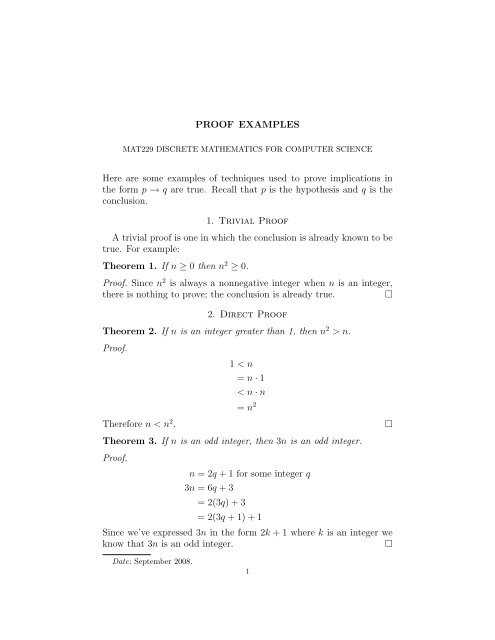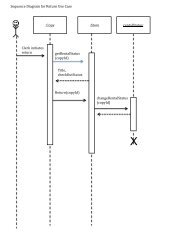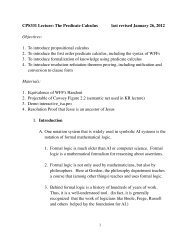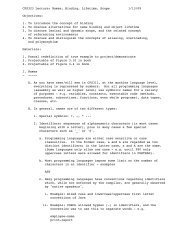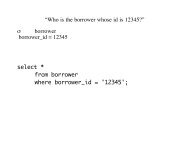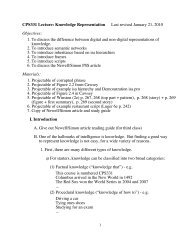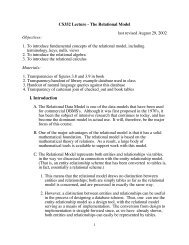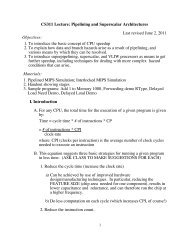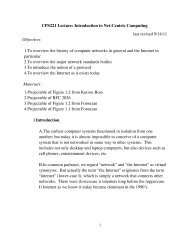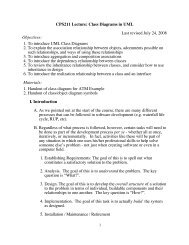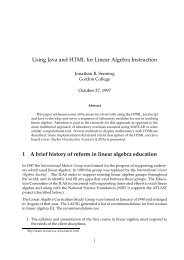Handout with examples - Department of Mathematics and Computer ...
Handout with examples - Department of Mathematics and Computer ...
Handout with examples - Department of Mathematics and Computer ...
You also want an ePaper? Increase the reach of your titles
YUMPU automatically turns print PDFs into web optimized ePapers that Google loves.
PROOF EXAMPLES<br />
MAT229 DISCRETE MATHEMATICS FOR COMPUTER SCIENCE<br />
Here are some <strong>examples</strong> <strong>of</strong> techniques used to prove implications in<br />
the form p → q are true. Recall that p is the hypothesis <strong>and</strong> q is the<br />
conclusion.<br />
1. Trivial Pro<strong>of</strong><br />
A trivial pro<strong>of</strong> is one in which the conclusion is already known to be<br />
true. For example:<br />
Theorem 1. If n ≥ 0 then n 2 ≥ 0.<br />
Pro<strong>of</strong>. Since n 2 is always a nonnegative integer when n is an integer,<br />
there is nothing to prove; the conclusion is already true.<br />
□<br />
2. Direct Pro<strong>of</strong><br />
Theorem 2. If n is an integer greater than 1, then n 2 > n.<br />
Pro<strong>of</strong>.<br />
1 < n<br />
= n · 1<br />
< n · n<br />
= n 2<br />
Therefore n < n 2 .<br />
□<br />
Theorem 3. If n is an odd integer, then 3n is an odd integer.<br />
Pro<strong>of</strong>.<br />
n = 2q + 1 for some integer q<br />
3n = 6q + 3<br />
= 2(3q) + 3<br />
= 2(3q + 1) + 1<br />
Since we’ve expressed 3n in the form 2k + 1 where k is an integer we<br />
know that 3n is an odd integer.<br />
□<br />
Date: September 2008.<br />
1
2 MAT229 DISCRETE MATHEMATICS FOR COMPUTER SCIENCE<br />
3. Indirect Pro<strong>of</strong><br />
Theorem 4. If 3n + 10 > 50 then n > 13.<br />
Pro<strong>of</strong>. Assume n ≤ 13. Then 3n ≤ 39 <strong>and</strong> so 3n+10 ≤ 49, which is the<br />
negation <strong>of</strong> the hypothesis (recall that ¬q → ¬p is logically equivalent<br />
to p → q).<br />
□<br />
Theorem 5. If n 2 is even then n is even.<br />
Pro<strong>of</strong>. Assume that n is odd. We will show that n 2 must also be odd.<br />
If n is odd then there is an integer k such that n = 2k + 1. In this<br />
case<br />
n 2 = (2k + 1) 2<br />
= 4k 2 + 4k + 1<br />
= 2(2k 2 + 2k) + 1<br />
Since n 2 is written as an even number plus one, it must be an odd<br />
number.<br />
We have just directly proved that “if n is odd then n 2 is odd” <strong>and</strong><br />
thereby indirectly proved our theorem “if n 2 is even then n is even.” □<br />
4. Pro<strong>of</strong> by Contradiction<br />
Theorem 6. √ 2 is an irrational number.<br />
Pro<strong>of</strong>. Assume that √ 2 rational, in which case it can be expressed as<br />
the ratio <strong>of</strong> two integers <strong>with</strong> no factors in common:<br />
√ a 2 =<br />
b<br />
where a <strong>and</strong> b are both integers <strong>with</strong> no factors in common <strong>and</strong> <strong>with</strong><br />
b ≠ 0. Clearing the fraction by multiplying both sides by b <strong>and</strong> squaring<br />
gives<br />
2b 2 = a 2<br />
From this we see that a 2 must be an even number since it is a multiple<br />
<strong>of</strong> 2 <strong>and</strong> from one <strong>of</strong> the above <strong>examples</strong> we know that if a 2 is even<br />
then a is even. Thus we can write a = 2c for some integer c. Our last<br />
equation then becomes<br />
2b 2 = (2c) 2<br />
= 4c 2<br />
b 2 = 2c 2<br />
Notice that the last line asserts that b 2 is an even number since it is a<br />
multiple <strong>of</strong> 2, <strong>and</strong> if b 2 is even then we know that b is even.
PROOF EXAMPLES 3<br />
We now have a contradiction. We began by assuming that √ 2 = a/b<br />
where a <strong>and</strong> b had no common factors but we’ve just found that both<br />
a <strong>and</strong> b are even numbers, meaning they both have 2 as a factor. Since<br />
this is impossible, it must be that our assumption that √ 2 is rational<br />
is false.<br />
□<br />
Theorem 7. Let g : A → B <strong>and</strong> f : B → C. If f <strong>and</strong> f ◦ g are both<br />
one-to-one functions then g is also a one-to-one function.<br />
Pro<strong>of</strong>. Assume that g is not one-to-one. Then ∃x 1 , x 2 ∈ A such that<br />
g(x 1 ) = g(x 2 ) = y for some y ∈ B. If f(y) = z for some z ∈ C then<br />
(f ◦ g)(x 1 ) = (f ◦ g)(x 2 ) = z, contradicting the fact that f ◦ g is oneto-one.<br />
Therefore it must not be possible that g is not one-to-one, <strong>and</strong><br />
so g is indeed a one-to-one function.<br />
□<br />
Theorem 8. |x| + |y| ≥ |x + y|<br />
5. Pro<strong>of</strong> by Cases<br />
Pro<strong>of</strong>. case 1: x ≥ 0, y ≥ 0. In this case |x + y| = x + y = |x| + |y|.<br />
case 2: x ≤ 0, y ≤ 0. Now |x + y| = −(x + y) = −x + (−y) = |x| + |y|.<br />
case 3: x ≥ 0, y ≤ 0.<br />
|x + y| = ||x| − |y||<br />
≤ ||x| + 2|y| − |y||<br />
= ||x| + |y||<br />
= |x| + |y|<br />
case 4: x ≤ 0, y ≥ 0. Here we merely need to reverse the roles <strong>of</strong> x<br />
<strong>and</strong> y in case 3.<br />
Since all possible cases have been h<strong>and</strong>led, <strong>and</strong> in each case we see that<br />
|x| + |y| ≥ |x + y|, we have prove the theorem.<br />
□


